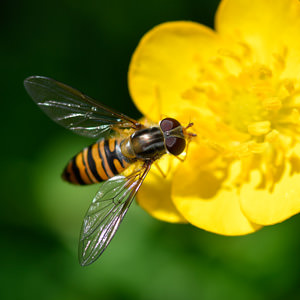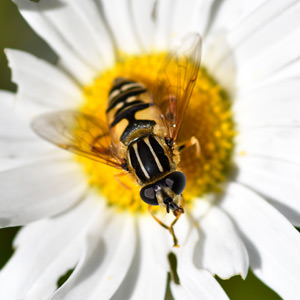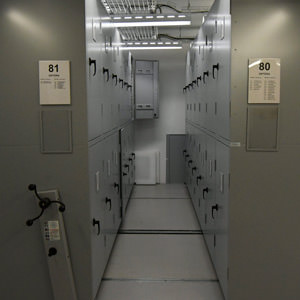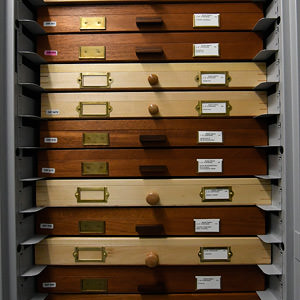
In his 1992 book The Diversity of Life the great American biologist Edward O. Wilson, who died last December, wrote the following chilling words:
So important are insects and other land-dwelling arthropods that if all were to disappear, humanity probably could not last more than a few months. Most of the amphibians, reptiles, birds, and mammals would crash to extinction about the same time. Next would go the bulk of the flowering plants and with them the physical structure of most forests and other terrestrial habitats of the world. The land surface would literally rot. As dead vegetation piled up and dried out, closing the channels of the nutrient cycles, other complex forms of vegetation would die off, and with them all but a few remnants of the land vertebrates. (Edward O. Wilson, The Diversity of Life, p. 125)
The Harvard professor re-issued those ideas in an essay entitled The Little Things That Run the World in his 1996 collection of essays In Search of Nature. No doubt Oliver Milman had that in mind when giving Insect Crisis its subtitle. It reminds us well that mankind does not run the world. Insects and other land-dwelling arthropods are busy doing that, as they have been for millennia.
This view has now entered the mainstream, even appearing on Buglife’s website as expressed by Sir David Attenborough:
If we and the rest of the back-boned animals were to disappear overnight, the rest of the world would get on pretty well. But if the invertebrates were to disappear, the world’s ecosystems would collapse.
Buglife, The Invertebrate Conservation Trust
Man’s very precarity is the central theme of Oliver Milman’s The Insect Crisis in which he ably explains how insects do indeed run the world and why we need to pay attention to their survival. You can consider this powerful book to be a companion volume to Dave Goulson’s Silent Earth: Averting the Insect Apocalypse (this site). Goulson is a professor of biology, Milman a journalist. Their two books tread very similar and complementary paths.
Where Goulson provided us with a penultimate-but-one chapter, A View from the Future, which looks back from an imaginary, shockingly-depleted dystopian environment of 2082, Milman’s short prologue to The Insect Crisis engages our attention by describing how the rapid collapse that Edward O. Wilson had set out might have unfolded. The fictional cataclysm began with a stillness, a silence, an absence of familiar insect noise. 10,000 species of birds starved. Pollinating insects, moths, beetles and flies vanished. 8,000 species of dung beetle went with them, and the animal faeces that they used to process began to pile up. Food supplies disintegrated. Apples, honey and coffee became expensive luxuries. Chocolate could not be bought. Our interesting colourful fruit and vegetables (the reds and greens that required pollination) disappeared from our tables, although mass starvation was averted thanks to wind-pollinated crops such as wheat, rice and maize. Vitamin deficiencies burgeoned. 90% of wild, flowering plants disappeared; gardens became deserts; wild meadows vanished. This was the fall of the tiny empires that used to run the world. In just four pages, Milman’s book secures our attention.
Having done so, four pages further in, he quotes Dr. Erica McAlister, fly expert at London’s Natural History Museum:
We’ve got 50,000 people studying one type of monkey and one person studying 50,000 types of flies.
The neatness of the arithmetic may be suspect, but the quote carries weight. (More on Dr. McAlister below.) Our ignorance about the role insects play (in our lives) is one of our greatest weaknesses, and science is uncovering this at a dramatic rate. Researchers, Milman observes, now believe that the planet may host 10 million insect species. (Wilson himself, back in 1992, wrote that even just tropical forest insect species might number as many as 30 million.) Who knows what work these unknown numbers really do and what the effect will be when we have destroyed them all through habitat loss and chemical ‘warfare’?
Pesticides, anthropogenic climate and man’s direct interference with pollinators are the three principle players in this tragic drama and Milman steps us through each of these. We learn that neonicotinoids have been found in 75% of honey samples that were taken worldwide, and that the effect of this on bees themselves is a form of lifelong brain damage. Further studies in France have shown that across 1,000 farms of all types, the majority would suffer no loss of production if they reduced their use of pesticides. Further, that 90 of these farms would increase their production if they reduced their used of insecticides. This relationship (between man’s action and its harmful or beneficial consequences) is speedy. The inevitable onset of climate change is less so, but the projections, on a broader front, remain grim. It is thought that by the end of the century, lacking major emissions reductions, half of all insect species will lose more than half of their habitable range. This is so much more than for vertebrates and for plants. Whatever insects are hanging on in the face of the chemical assault will be truly clobbered by climate change. What to make, then, of the transport of 85% of all commercially kept honeybee colonies in the Unites States, which are loaded onto trucks and wheeled around the country (mostly to satisfy the demands of the almond-growing industry in California)?
Milman elicits our sympathy for a range of insects. None are not wondrous in their own right. Many have commercial value. He also engages our intellect with substantial statistics - and 18 pages of footnotes. Various farmers and scientists stand out as personalities. In addition to Dr. McAlister, there is Anders Pape Møller, the Danish biologist famed for having driven his aged Ford Anglia along the same stretches of road since 1997 until today, measuring - with help from his PhD students - the number of insects smeared across the windscreen. In more than 20 years, he measured an 80% decline in the count on one route, and a 97% decline on the other route. For those of us who have been driving throughout this period, we may not be that surprised. Now there are scientific measurements, sadly, to substantiate our suspicions.
Dave Goulson introduced the ‘shifting-baseline syndrome’ whereby over time we gradually adjust our expectations and forget what once was. Both writers discuss this and both cite the work of marine ecologist Loren McClenachan who researched historical photographs of fishing enthusiasts with their catches in Florida’s Key West. At the end of their trips, customers line up for a mugshot holding their piscine trophies. In the 1950s, customers were being dwarfed by their catches. In the 1970s, their catches were usually the same height as the customers. Today, they might get to be about a foot long. The smiles of all seemed to be just as big. Both these books help us guard against adaptability becoming a form of amnesia.
The sixth mass extinction is upon us, Milman reminds us. Insects survived all previous extinctions. This one is likely to be their first. We need them more than they need us.
These events are happening on too large a scale for individuals on their own to retard. Collective action would perhaps be a different matter, and Milman cites an American researcher who has calculated that if half of that country’s homeowners converted their land to native plants, they would have created more habitat for insects than all of the national parks in the lower forty-eight states combined, thereby helping to open up connected wildlife corridors.
If you have a garden, help hand it over to pollinators by planting pollinator-friendly plants and flowers, and by reducing the amount you mow. If you use weedkiller, don’t. Write to your MP; add your voice to those already lobbying local councillors. Books such as The Insect Crisis may motivate us to do more than just read more books like The Insect Crisis.
My local pollinators
As I wrote when reviewing Dave Goulson’s Silent Earth, “I am lucky to be able to be able to participate in a local ‘citizen science’ project to keep a closed cemetery (one that’s ‘full up’ and no longer open to the public) free of chemicals and full of pollinator-friendly plants (instead of severely-clipped neatness)”. The species count in that 0.4 hectare town-centre space was then 380. As I write this review, it’s nudged its way up to 453. (Some of those have been from delightfully varied hoverfly families.) In support of this review, here are some further photographs taken in Heene Cemetery. In this instance, all of them are pollinators.
Footnote: hoverflies in London’s Natural History Museum
Enthused by my own photography of hoverflies in Heene Cemetery and by Oliver Milman’s mention of Dr. Erica McAlister, the fly expert at London’s Natural History Museum, I emailed Dr. McAlister to see if I might be allowed to view the museum’s collection of British hoverflies - as you do. She referred me to her colleague, Nigel Wyatt, the museum’s Curator of Diptera (Aschiza & Calyptrata), and he was kind enough to welcome me onto the museum’s hallowed turf.
Deep in that Victorian nature cathedral on the Cromwell Road, there’s an air-conditioned corridor that contains a double row of grey steel sliding doors. Behind each door is a passage flanked with 28 smaller locked doors. Inside each of these are serried ranks of wooden, glass-topped drawers, perhaps 20 at a time. In each is a collection of pinned insects dating back to the mid-nineteenth century. I asked to see British hoverflies, of which there are perhaps 283 different species. There were 150 drawers of these. They function as the country’s reference collection of hoverflies. Protected from UV light, their colours are undimmed with age.
In the whole air-conditioned zone, there were some 8,000 drawers containing around 3 million fly specimens. There is an attempt ongoing to digitize this collection which may, amongst other things, reveal the chronology and geography of these individual specimens. But this won’t reveal population change over time. There is also currently no data-logging of disappearing species or of days when the count is zero for any given species. For that, we can consult our own nearly insect-free car windscreens at the end of any of the longer journeys that we may still make.
[The Insect Crisis: The Fall of the Tiny Empires that Run the World by Oliver Milman is available in the UK from Hive.co.uk.]











